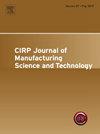A genetic algorithm-calibrated heat source model for reconstructing thermal history and precipitate evolution in additive friction stir multilayer deposition
IF 5.4
2区 工程技术
Q2 ENGINEERING, MANUFACTURING
CIRP Journal of Manufacturing Science and Technology
Pub Date : 2025-06-10
DOI:10.1016/j.cirpj.2025.06.003
引用次数: 0
Abstract
Additive friction stir deposition (AFSD) has shown significant potential for additive manufacturing of large structures, which involves unique thermal cycling effects in multilayer deposition. The present endeavor firstly attempts to develop a universal moving heat source model (the double-hump model) for finite element multilayer thermal simulation, which mathematically simplifies the non-uniform distribution of macroscopic heat flux densities in the deposition zone. By adopting a planar heat source formulation, the model consequently neglects the radial contribution of plastic dissipation. The main objective is to seek a convenient simulation means to reconstruct the thermal history of the multilayer deposition and to get its impact on the precipitate evolution and mechanical properties. The heat source model parameters were determined by a genetic algorithm based on the principle of monarch selection and uniform crossover strategy to match the experimental data. The temperatures predicted by the finite element model for the preheating and multilayer deposition stages agreed well with those obtained experimentally. The location of the maximum heat flux density in the deposition zone was evaluated for the first time. The simulation data and characterization results show that the simulation of the multilayer AFSD process based on the heat source model can effectively reflect the second phase evolution in the thermal cycle and the influence on the mechanical properties. Furthermore, this study presents a novel thermal analysis of distinctive phenomena occurring in the AFSD process, showing the potential of heat source modelling in the thermal simulation of multilayer deposition.
一种基于遗传算法标定的热源模型,用于重建搅拌摩擦多层沉积的热历史和沉淀演化
添加剂搅拌摩擦沉积(AFSD)在大型结构的增材制造中显示出巨大的潜力,它涉及多层沉积中独特的热循环效应。本文首先尝试建立一种用于有限元多层热模拟的通用运动热源模型(双驼峰模型),该模型从数学上简化了沉积区宏观热流密度的不均匀分布。该模型采用平面热源公式,因此忽略了塑性耗散的径向贡献。主要目的是寻求一种方便的模拟手段来重建多层沉积的热历史,并获得其对析出相演化和力学性能的影响。采用基于君主选择原则和均匀交叉策略的遗传算法确定热源模型参数,以匹配实验数据。有限元模型预测的预热和多层沉积阶段的温度与实验结果吻合较好。首次确定了沉积区最大热流密度的位置。仿真数据和表征结果表明,基于热源模型的多层AFSD过程仿真能够有效反映热循环过程中的第二相演变及其对力学性能的影响。此外,本研究对AFSD过程中出现的独特现象进行了新的热分析,显示了热源建模在多层沉积热模拟中的潜力。
本文章由计算机程序翻译,如有差异,请以英文原文为准。
求助全文
约1分钟内获得全文
求助全文
来源期刊

CIRP Journal of Manufacturing Science and Technology
Engineering-Industrial and Manufacturing Engineering
CiteScore
9.10
自引率
6.20%
发文量
166
审稿时长
63 days
期刊介绍:
The CIRP Journal of Manufacturing Science and Technology (CIRP-JMST) publishes fundamental papers on manufacturing processes, production equipment and automation, product design, manufacturing systems and production organisations up to the level of the production networks, including all the related technical, human and economic factors. Preference is given to contributions describing research results whose feasibility has been demonstrated either in a laboratory or in the industrial praxis. Case studies and review papers on specific issues in manufacturing science and technology are equally encouraged.
 求助内容:
求助内容: 应助结果提醒方式:
应助结果提醒方式:


